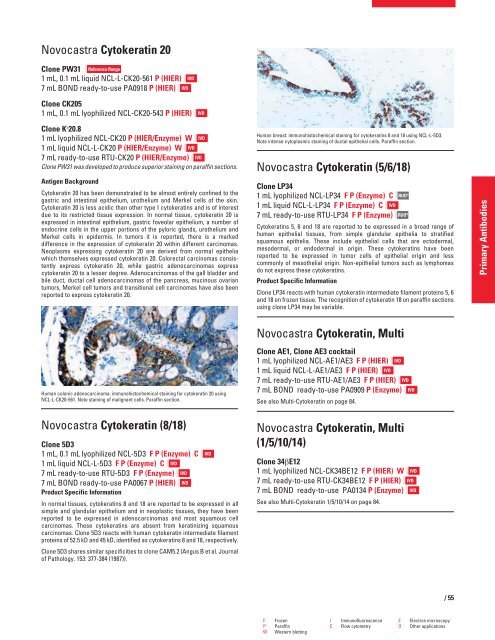QF0159 Marketing Release Record
QF0159 Marketing Release Record
QF0159 Marketing Release Record
You also want an ePaper? Increase the reach of your titles
YUMPU automatically turns print PDFs into web optimized ePapers that Google loves.
Novocastra Cytokeratin 20<br />
Clone PW31 Reference Range<br />
1 mL, 0.1 mL liquid NCL-L-CK20-561 P (HIER)<br />
7 mL BOND ready-to-use PA0918 P (HIER)<br />
Clone CK205<br />
1 mL, 0.1 mL lyophilized NCL-CK20-543 P (HIER)<br />
Clone Ks20.8 1 mL lyophilized NCL-CK20 P (HIER/Enzyme) W IVD<br />
1 mL liquid NCL-L-CK20 P (HIER/Enzyme) W IVD<br />
7 mL ready-to-use RTU-CK20 P (HIER/Enzyme) IVD<br />
Clone PW31 was developed to produce superior staining on paraffin sections.<br />
Antigen Background<br />
Cytokeratin 20 has been demonstrated to be almost entirely confined to the<br />
gastric and intestinal epithelium, urothelium and Merkel cells of the skin.<br />
Cytokeratin 20 is less acidic than other type I cytokeratins and is of interest<br />
due to its restricted tissue expression. In normal tissue, cytokeratin 20 is<br />
expressed in intestinal epithelium, gastric foveolar epithelium, a number of<br />
endocrine cells in the upper portions of the pyloric glands, urothelium and<br />
Merkel cells in epidermis. In tumors it is reported, there is a marked<br />
difference in the expression of cytokeratin 20 within different carcinomas.<br />
Neoplasms expressing cytokeratin 20 are derived from normal epithelia<br />
which themselves expressed cytokeratin 20. Colorectal carcinomas consistently<br />
express cytokeratin 20, while gastric adenocarcinomas express<br />
cytokeratin 20 to a lesser degree. Adenocarcinomas of the gall bladder and<br />
bile duct, ductal cell adenocarcinomas of the pancreas, mucinous ovarian<br />
tumors, Merkel cell tumors and transitional cell carcinomas have also been<br />
reported to express cytokeratin 20.<br />
Human colonic adenocarcinoma: immunohistochemical staining for cytokeratin 20 using<br />
NCL-L-CK20-561. Note staining of malignant cells. Paraffin section.<br />
Novocastra Cytokeratin (8/18)<br />
Clone 5D3<br />
1 mL, 0.1 mL lyophilized NCL-5D3 F P (Enzyme) C<br />
1 mL liquid NCL-L-5D3 F P (Enzyme) C IVD<br />
7 mL ready-to-use RTU-5D3 F P (Enzyme)<br />
7 mL BOND ready-to-use PA0067 P (HIER)<br />
Product Specific Information<br />
In normal tissues, cytokeratins 8 and 18 are reported to be expressed in all<br />
simple and glandular epithelium and in neoplastic tissues, they have been<br />
reported to be expressed in adenocarcinomas and most squamous cell<br />
carcinomas. These cytokeratins are absent from keratinizing squamous<br />
carcinomas. Clone 5D3 reacts with human cytokeratin intermediate filament<br />
proteins of 52.5 kD and 45 kD, identified as cytokeratins 8 and 18, respectively.<br />
Clone 5D3 shares similar specificities to clone CAM5.2 (Angus B et al. Journal<br />
of Pathology. 153: 377-384 (1987)).<br />
IVD<br />
IVD<br />
IVD<br />
IVD<br />
IVD<br />
IVD<br />
Human breast: immunohistochemical staining for cytokeratins 8 and 18 using NCL-L-5D3.<br />
Note intense cytoplasmic staining of ductal epithelial cells. Paraffin section.<br />
Novocastra Cytokeratin (5/6/18)<br />
Clone LP34<br />
1 mL lyophilized NCL-LP34 F P (Enzyme) C<br />
1 mL liquid NCL-L-LP34 F P (Enzyme) C IVD<br />
7 mL ready-to-use RTU-LP34 F P (Enzyme)<br />
Cytokeratins 5, 6 and 18 are reported to be expressed in a broad range of<br />
human epithelial tissues, from simple glandular epithelia to stratified<br />
squamous epithelia. These include epithelial cells that are ectodermal,<br />
mesodermal, or endodermal in origin. These cytokeratins have been<br />
reported to be expressed in tumor cells of epithelial origin and less<br />
commonly of mesothelial origin. Non-epithelial tumors such as lymphomas<br />
do not express these cytokeratins.<br />
Product Specific Information<br />
Clone LP34 reacts with human cytokeratin intermediate filament proteins 5, 6<br />
and 18 on frozen tissue. The recognition of cytokeratin 18 on paraffin sections<br />
using clone LP34 may be variable.<br />
Novocastra Cytokeratin, Multi<br />
Clone AE1, Clone AE3 cocktail<br />
1 mL lyophilized NCL-AE1/AE3 F P (HIER)<br />
1 mL liquid NCL-L-AE1/AE3 F P (HIER)<br />
7 mL ready-to-use RTU-AE1/AE3 F P (HIER)<br />
7 mL BOND ready-to-use PA0909 P (Enzyme)<br />
See also Multi-Cytokeratin on page 84.<br />
Novocastra Cytokeratin, Multi<br />
(1/5/10/14)<br />
Clone 34�E12<br />
1 mL lyophilized NCL-CK34BE12 F P (HIER) W<br />
7 mL ready-to-use RTU-CK34BE12 F P (HIER)<br />
7 mL BOND ready-to-use PA0134 P (Enzyme)<br />
See also Multi-Cytokeratin 1/5/10/14 on page 84.<br />
F Frozen I Immunofluorescence E Electron microscopy<br />
P Paraffin C Flow cytometry O Other applications<br />
W Western blotting<br />
IVD<br />
IVD<br />
RUO*<br />
RUO*<br />
IVD<br />
IVD<br />
IVD<br />
IVD<br />
IVD<br />
/55<br />
Primary Antibodies
















